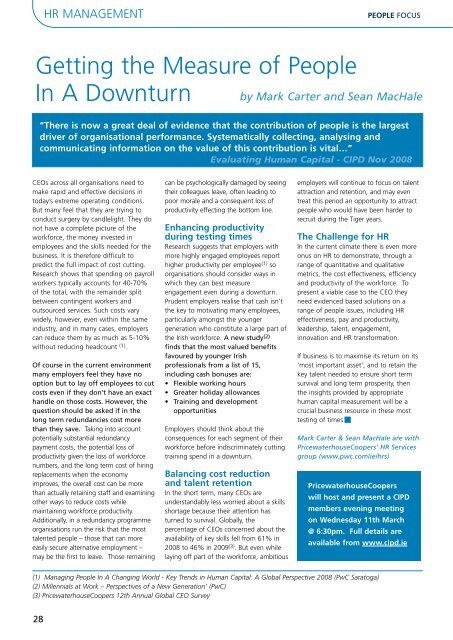PEOPLE FOCUS - CIPD
PEOPLE FOCUS - CIPD
PEOPLE FOCUS - CIPD
Create successful ePaper yourself
Turn your PDF publications into a flip-book with our unique Google optimized e-Paper software.
HR MANAGEMENT<br />
<strong>PEOPLE</strong> <strong>FOCUS</strong><br />
Getting the Measure of People<br />
In A Downturn by Mark Carter and Sean MacHale<br />
“There is now a great deal of evidence that the contribution of people is the largest <br />
driver of organisational performance. Systematically collecting, analysing and <br />
communicating information on the value of this contribution is vital…”<br />
Evaluating Human Capital - <strong>CIPD</strong> Nov 2008<br />
CEOs across all organisations need to<br />
make rapid and effective decisions in<br />
today’s extreme operating conditions.<br />
But many feel that they are trying to<br />
conduct surgery by candlelight. They do<br />
not have a complete picture of the<br />
workforce, the money invested in<br />
employees and the skills needed for the<br />
business. It is therefore difficult to<br />
predict the full impact of cost cutting.<br />
Research shows that spending on payroll<br />
workers typically accounts for 40-70%<br />
of the total, with the remainder split<br />
between contingent workers and<br />
outsourced services. Such costs vary<br />
widely, however, even within the same<br />
industry, and in many cases, employers<br />
can reduce them by as much as 5-10%<br />
without reducing headcount (1) .<br />
Of course in the current environment<br />
many employers feel they have no<br />
option but to lay off employees to cut<br />
costs even if they don’t have an exact<br />
handle on those costs. However, the<br />
question should be asked if in the<br />
long term redundancies cost more<br />
than they save. Taking into account<br />
potentially substantial redundancy<br />
payment costs, the potential loss of<br />
productivity given the loss of workforce<br />
numbers, and the long term cost of hiring<br />
replacements when the economy<br />
improves, the overall cost can be more<br />
than actually retaining staff and examining<br />
other ways to reduce costs while<br />
maintaining workforce productivity.<br />
Additionally, in a redundancy programme<br />
organisations run the risk that the most<br />
talented people – those that can more<br />
easily secure alternative employment –<br />
may be the first to leave. Those remaining<br />
can be psychologically damaged by seeing<br />
their colleagues leave, often leading to<br />
poor morale and a consequent loss of<br />
productivity effecting the bottom line.<br />
Enhancing productivity<br />
during testing times<br />
Research suggests that employers with<br />
more highly engaged employees report<br />
higher productivity per employee (1) so<br />
organisations should consider ways in<br />
which they can best measure<br />
engagement even during a downturn.<br />
Prudent employers realise that cash isn’t<br />
the key to motivating many employees,<br />
particularly amongst the younger<br />
generation who constitute a large part of<br />
the Irish workforce. A new study (2)<br />
finds that the most valued benefits<br />
favoured by younger Irish<br />
professionals from a list of 15,<br />
including cash bonuses are:<br />
• Flexible working hours<br />
• Greater holiday allowances<br />
• Training and development<br />
opportunities<br />
Employers should think about the<br />
consequences for each segment of their<br />
workforce before indiscriminately cutting<br />
training spend in a downturn.<br />
Balancing cost reduction<br />
and talent retention<br />
In the short term, many CEOs are<br />
understandably less worried about a skills<br />
shortage because their attention has<br />
turned to survival. Globally, the<br />
percentage of CEOs concerned about the<br />
availability of key skills fell from 61% in<br />
2008 to 46% in 2009 (3) . But even while<br />
laying off part of the workforce, ambitious<br />
employers will continue to focus on talent<br />
attraction and retention, and may even<br />
treat this period an opportunity to attract<br />
people who would have been harder to<br />
recruit during the Tiger years.<br />
The Challenge for HR<br />
In the current climate there is even more<br />
onus on HR to demonstrate, through a<br />
range of quantitative and qualitative<br />
metrics, the cost effectiveness, efficiency<br />
and productivity of the workforce. To<br />
present a viable case to the CEO they<br />
need evidenced based solutions on a<br />
range of people issues, including HR<br />
effectiveness, pay and productivity,<br />
leadership, talent, engagement,<br />
innovation and HR transformation.<br />
If business is to maximise its return on its<br />
‘most important asset’, and to retain the<br />
key talent needed to ensure short term<br />
survival and long term prosperity, then<br />
the insights provided by appropriate<br />
human capital measurement will be a<br />
crucial business resource in these most<br />
testing of times ■<br />
Mark Carter & Sean MacHale are with<br />
PricewaterhouseCoopers’ HR Services<br />
group (www.pwc.com/ie/hrs)<br />
PricewaterhouseCoopers<br />
will host and present a <strong>CIPD</strong><br />
members evening meeting<br />
on Wednesday 11th March<br />
@ 6:30pm. Full details are<br />
available from www.cipd.ie<br />
(1) Managing People In A Changing World - Key Trends in Human Capital: A Global Perspective 2008 (PwC Saratoga)<br />
(2) Millennials at Work – Perspectives of a New Generation’ (PwC)<br />
(3) PricewaterhouseCoopers 12th Annual Global CEO Survey<br />
28

















